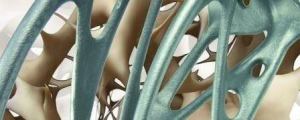Blog Archives
Additive Manufacturing at the Mechanical Engineering Summit
Berlin, October 22nd, 2014 – Will additive manufacturing (AM; generally known as 3D printing) change the world of our industrial processes? To which uses can we put this new technology already today, where does it still have potential for optimization? – Across the world, these questions affect mechanical and plant engineers, industrial users, researchers, and politicians.
At the 7th German Mechanical Engineering Summit in Berlin, experts gave insights into the technology’s current status. Additive manufacturing is an umbrella term for procedures which realize components directly from construction data files without the detour of tool and mold construction. Since the erection of three-dimensional structures happens layer by layer, this allows for production of highly complex components which could not be produced so far. In addition, small-volume batches down to batch size 1 become affordable. There is no limit to individualization of mass production. Spare parts out of data files and printer could replace storage in the future. But which part of this is a vision – and which is reality?
Industrial use next to basic research
“Additive manufacturing already possesses a maturity surpassing prototypes by far”, Rainer Lotz explained, general manager at the plant engineering company Renishaw. It could already be suitable and cost-efficient for small-volume batch production. All the more so if calculation encompasses the whole procedure including superior workpiece function – for example light weight construction or integration of functions. Renishaw develops, produces, and sells systems which produce components layer by layer out of finely powdered metals with a laser melting procedure. Demand for such systems is increasing rapidly.
Still, Prof. Dr.-Ing. Michael Schmidt, chairholder for Photon Technologies at the Friedrich-Alexander University Erlangen-Nürnberg, warned in Berlin against overestimating the maturity of additive manufacturing. While rapid growth of industrial use proves its enormous market potential, it also shows many companies’ disposition to adapt the young technology’s progress immediately. Nevertheless, all of it still happens in a very narrow process window. “It is absolutely necessary to further basic research, and to coordinate these efforts more than has been done so far,” Schmidt urged at the Mechanical Engineering Summit.
“We need a much deeper understanding of processes and materials,” Schmidt said. For in order to open up the whole potential of additive manufacturing, it is vital to broaden the so far limited choice of materials. In addition, it is necessary to reach a higher reproducibility of component properties via more exact process engineering. Mechanical and plant engineers, suppliers, and also researchers were called upon to devolop solutions suitable for industrial use for process interface equipment of today’s systems.
Additive manufacturing on the way to industry 4.0
Despite the conflicting priorities of specific industrial use and the necessity for in-depth basic research, Dr. Robert Neuhauser, general manager atSiemens AG for their branch Motion Control Systems, observes a definite trend towards industrial AM applications within mechanical engineering. Here, additive manufacturing combines with machining technologies and line concepts. “This has far-reaching consequences: procedures in the facilities change dramatically, and core competences shift from manufacture towards early phases of product life cycles – design, construction, optimization, and verification, also with help of cyber-physical systems,” he elaborated.
This shift creates a need for maximum digital consistency of data: from idea sketches up to logged production data for end-to-end tracking and tracing. The path points towards industry 4.0, and in Berlin, Neuhauser provided this catchphrase with specific meaning: “Additive manufacturing needs a consistent platform from design tools to machine automation, covering all relevant additive manufacturing procedures,” he explained. Siemens already supports these requirements in several ways, for example through the “Digital Enterprise Platform”, and through their Automation and Motion Control Solutions.
The Additive Manufacturing Association within VDMA
The exchange of experiences between mechanical engineers, users, and researchers did not start at the Mechanical Engineering Summit in Berlin. Already at the end of May 2014, the Additive Manufacturing Association within VDMA was constituted, initiated by the Printing and Paper Technologies Association within VDMA and the German Machine Tool Builders’ Association (VDW). “By now, we have approximately 60 members along the whole value chain of additive manufacturing,” Rainer Gebhardt explains, the Association’s project manager. This open and international association is meant to be a coordinating platform to facilitate communication between players of additive manufacturing, concerning questions on practical experience, research, development, as well as standardization. The Association’s website at http://am.vdma.org also serves this goal.
Contact
Rainer Gebhardt
Additive Manufacturing Association within VDMA
Tel: +49 (0)69 6603-1902
rainer.gebhardt@vdma.org
Source of the image : LZN Laser Zentrum Nord GmbH, Fotolia

